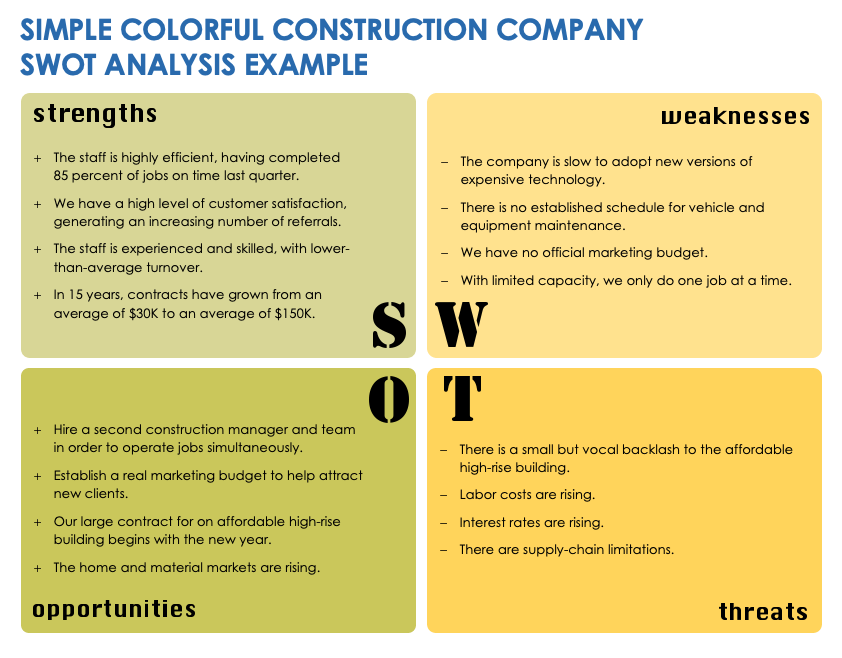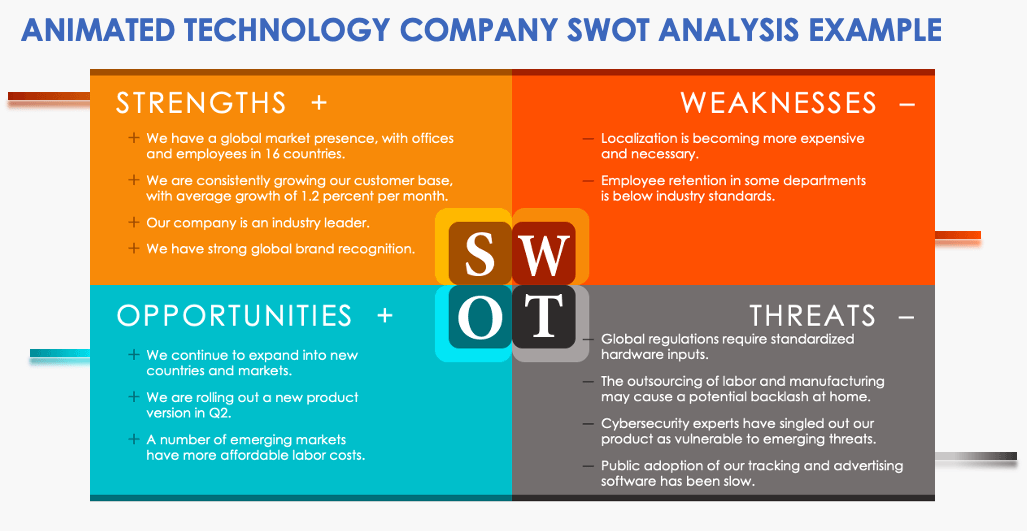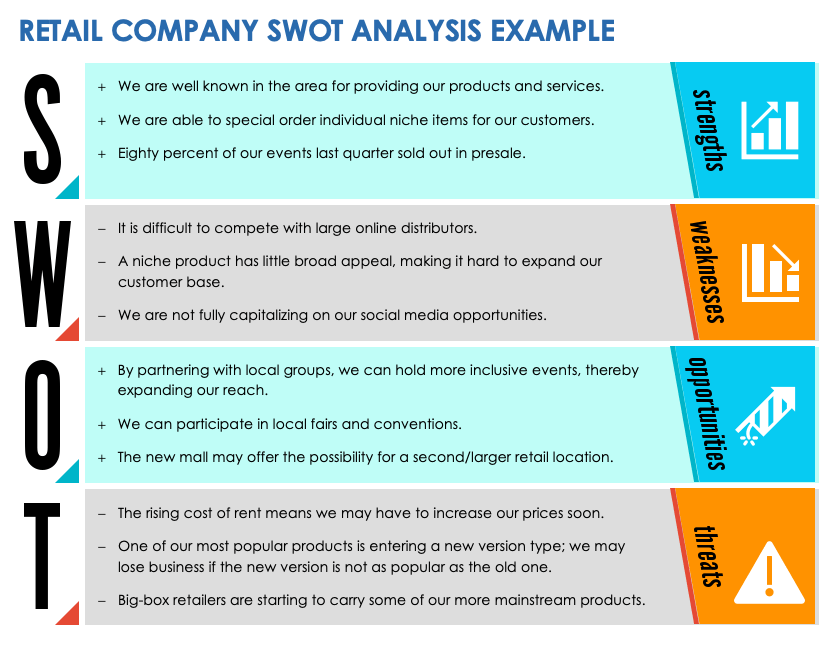How to Do a SWOT Analysis
To perform a SWOT (strength, weakness, opportunities, and threats) analysis, assemble a matrix and take an objective look at your business. Write down your observations, summarize your findings, and plan your next steps together with your team.
“A SWOT analysis is designed to shed light on four separate aspects of your business and help in strategy formation and project planning. In order to perform this analysis comprehensively, each factor must be examined in equal measure,” explains Max Wesman, the Founder of GoodHire.
We’ve outlined the steps necessary for completing a SWOT analysis:
- Assemble Your Team
Include a diverse group in your analysis to get the best results. Ask for input from people on different teams and at varying employee tiers and demographics to get an objective look at your business. “Plan a half-day strategy session with your team and have each member come ready to present their own SWOT analysis of a particular product or opportunity. You’ll be surprised by the range of new ideas it generates. And you can use the exercise to formulate an aggregate SWOT that you all buyinto together,” suggests Jack Colletti, the Founder of Colletti Labs. - Set Up Your Matrix
Use a template, whiteboard, shared online workspace, or paper and pen to create a matrix. For free template ideas and downloads, check out our collections of SWOT templates available in PowerPoint, Microsoft Word, Google Docs, and Google Slides formats. - Fill in the Matrix
- Crowdsource answers from your team, or combine everyone’s individual contributions into one matrix. “The most important thing to do when performing a SWOT analysis is to be thorough and factual in recording your data, so that you’ll have the most accurate results possible. Don’t make the mistake of looking too hard for the negatives or thinking that the positives give you the whole picture. Strive to be impartial when adding items to each quadrant,” advises Adam Rossi, the CEO of TotalShield Safety Enclosures.
Complete the four quadrants of a SWOT analysis:
- Strengths: To identify your strengths, ask yourself what you’re doing well and what your customers and employees like about your business.
- Weaknesses: To identify weaknesses, look at places where you have fallen short of projections. Read reviews of your business and pay attention to critical customer feedback.
- Opportunities: To identify opportunities, start with your long- and short-term goals. Ask yourself if there are new products or services you can add to your lineup to set you apart, any gaps in the market you can fill, or any areas that could benefit from a different allocation of resources.
- Threats: To identify threats to your business, keep an eye on your competition, upcoming legislative changes, and financial records and projections. Pay attention to the potential for negative media and social media coverage due to your business practices, as well.
- Organize and Summarize
As a group, rank items by how actionable they are or by their impact. “Be sure that you don’t make your list too long to manage,” suggests Rossi. Choose the top five or six responses for each quadrant to help focus the discussion and analysis. - Plan Your Next Steps
Create action items and a plan for moving forward. Depending on the results of your analysis, this will likely mean some combination of bolstering your strengths, shoring up your weaknesses, taking advantage of opportunities, and mitigating threats. - Store the Analysis for Easy Reference
It is a good idea to perform a SWOT analysis regularly — depending on your business size, you might repeat the practice annually or quarterly. Before performing a new SWOT analysis, review the previous one and see where you’ve made improvements. “Routinely revisiting your SWOT analysis ensures that your evaluation is accurate and up-to-date with the current state of the market,” says Wesman.
SWOT Analysis Starter Kit
Download the SWOT Analysis Starter Kit
We’ve created this starter kit to give you the necessary tools to think through and conduct a SWOT analysis for your business. You’ll find SWOT templates in multiple formats, a checklist of actions to take and questions to ask, and a presentation template. All of these templates are fully customizable and can be adapted for personal decision-making. Download each template individually or as a complete kit.
Included in this download, you’ll find:
- A blank animated SWOT analysis template for PowerPoint to help create an engaging SWOT presentation.
- A blank horizontal, landscape-oriented SWOT analysis template for Microsoft Word to create an eye-catching display or a handout with plenty of room for text.
- A blank simple, portrait-oriented SWOT matrix template for Microsoft Word and Google Docs for easy brainstorming and sharing.
- A blank custom photo SWOT matrix template for PowerPoint and Google Slides to create a dynamic, personalized presentation of your analysis.
- A SWOT analysis checklist for Microsoft Word so that each step of your analysis goes off without a hitch.
- A common SWOT analysis examples checklist for Microsoft Word to reference and copy from when completing your SWOT template.
- A group SWOT analysis presentation for PowerPoint to help facilitate a group SWOT analysis meeting.
SWOT Analysis Examples
A SWOT analysis can help a wide variety of businesses identify their strengths, weaknesses, opportunities, and threats. We’ve collected some SWOT analysis examples that demonstrate how they’re used in construction, technology, and retail industries.
Construction Company SWOT Analysis Example for Google Docs
Download the Simple Colorful Construction Company SWOT Template for Google Docs
Download the Simple Colorful Construction Company SWOT Template for Google Docs with Sample Data
This simple but colorful SWOT template includes example data for a construction company concerned about its growth. In the sample, the company has identified the experience of their staff as a strength, as well as their growth as a business over the last 15 years. They know they need to be more open to adopting new technology, and they acknowledge they have no marketing budget and only attract new clients by word-of-mouth. They use this info to focus their opportunities on leveraging their existing staff to train new teams, and creating a specific budget for marketing. Finally, they have identified the rising costs of labor and the chance of public backlash to a project they are working on as threats to their business.
Technology Company SWOT Analysis Example for PowerPoint
Download the Blank Animated Technology SWOT Analysis for PowerPoint
Download the Animated Technology SWOT Analysis Template for PowerPoint with Sample Data
This animated SWOT analysis template is excellent for showing off your SWOT findings in a meeting or presentation setting. It includes animations to reveal each quadrant of your matrix as you speak. This template includes sample data for a large technology company that has recognized its worldwide presence and growing customer base as strengths, and the requirements of localization and employee retention as weaknesses. The organization is looking ahead to the opportunities presented by decreased labor costs in emerging markets, but also paying attention to the threat of cybersecurity and potential backlash in their home country due to their outsourcing of labor and manufacturing.
Retail Company SWOT Analysis Example for Microsoft Word
Download the Blank Horizontal Retail SWOT Template for Microsoft Word
Download the Horizontal Retail SWOT Template for Microsoft Word with Sample Data
This horizontal-oriented SWOT template includes example data for a retail store. In the sample version of the template, the store has outlined its strengths but also noted concerns about the rising costs of rent and the abundance of big-box stores and included those in the threats section. They have identified opportunities as participation in local events and the possibility of a second storefront. The store also recognized that it could improve its social media efforts and the difficulty in competing with larger, online retailers.
What Is a SWOT Analysis?
A SWOT analysis is a strategic assessment tool that weighs strengths, weaknesses, opportunities, and threats to aid in decision-making. A SWOT analysis can help guide you to better-informed conclusions that are more likely to produce long-term benefits.
Invented by Albert Humphrey at the Stanford Research Institute in the 1960s, the SWOT analysis framework has been adopted by businesses and individual decision-makers worldwide. Humphrey’s framework prioritizes the analysis of internal strengths and weaknesses; the related TOWS analysis model flips this on its head and focuses on external opportunities and threats. Another external analysis model, the PEST (political, economic, social, and technological) framework, focuses entirely on external factors, namely political, economical, sociocultural, and technological.
“The SWOT analysis is an excellent framework not only for diagnosing issues in your business, but also for identifying strategic opportunities within it. For example, a SWOT analysis can be applied to the launch of a new product, a business partnership under consideration, or a key hire or promotion. While the SWOT is not meant to be an all-inclusive, fully exhaustive analysis, it does provide a solid basis for discussion, much like a resume or CV contributes to the hiring process,” explains Colleti of Colletti Labs.
Strength in a SWOT Analysis
The strengths section of a SWOT analysis highlights what you do well. These can include your sales and market presence, hiring and retention practices, and products and services, among others. It can also list what you are good at personally.
Some additional examples of strengths you might list in a SWOT analysis include:
- Customer Satisfaction: Satisfied customers are returning customers. Returning customers keep your business solvent. Having a large number of regular customers is a great strength.
- Effective Branding: The right branding makes a business memorable. A well-designed logo or a fun, topical ad campaign can bring in sales and create positive associations with your brand.
- Employee Satisfaction and Retention: Hiring quality talent and retaining them for the long term is a wonderful strength. Loyal employees are more likely to enjoy their work and work harder because of it.
- Expertise: Business leaders often have expertise in their field that translates to a better product or service. Possessing more expertise than your competitors is a noteworthy strength.
- Filling a Niche: Identifying and filling a niche in the market is an excellent strength. Many businesses thrive because they are able to tap into the needs of their market and provide it for their customers.
- Leadership: Great leadership is a great strength. Leaders who inspire and support their teammates foster a happier and more cohesive workplace.
- Longevity: The longer your business has been around, the longer you have had to cultivate a positive reputation in your community. Businesses often celebrate their anniversaries and promote the time they have spent operating in the community. Longevity helps assure customers that you have expertise in your niche.
- Meeting and Exceeding Goals: Setting and achieving realistic goals is a sign of a well-run business.
- Product and Service Offerings: Unique or popular product and service offerings help a business carve out a niche and find their customer base, making them an obvious strength.
- Sales: Consistently high sales are desirable for any business and, therefore, a major strength. Robust sales can also lead to many other strengths, as well.
Identifying strengths impartially can be challenging. Use this list of questions to help pinpoint your strengths:
- How has your company grown?
- What do your customers like about you in reviews?
- What do your employees like about working for you?
- What does your company do that is unique?
- What offerings or company philosophies set you apart?
- What looks different about your business from one, five, and ten years ago?
Weakness in a SWOT Analysis
Weaknesses in a SWOT analysis are business aspects that are underperforming. These could be low sales, unpopular services, limitations, negative reviews, or others. Consider your weaknesses carefully, as you can often turn them into opportunities.
Here’s a list of common weaknesses businesses might find in a SWOT analysis:
- Employee Satisfaction: Employees who are unhappy with their jobs are less engaged and less productive. Consider your employees’ satisfaction, as retention can easily become a weakness of the business.
- Inefficient Budget and Resource Allocation: Many businesses have enough but do not allocate them efficiently. This weakness can be easily addressed by implementing better project prioritization practices.
- Negative Customer Reviews: Look at what your customers are saying in their reviews. Note the comments that show up frequently, and remember that customers will only typically leave very positive or very negative reviews. Use negative reviews as a tool to identify the areas where your business can improve.
- Not Reading Trends: Your products and services can quickly become obsolete if you are not in the habit of reading and forecasting trends.
- Poor Branding: Consider branding carefully. It should be consistent, representative of your company, and recognizable across all mediums.
- Poor Leadership: Solid leadership is critical to the success of a business. As such, leadership that doesn’t perform well should be addressed immediately.
- Product or Service Offerings: Product or service offerings can be a weakness if they are not unique to your business or better than similar offerings from your competitors.
- Resource Limitations: Resources might include money, people, or materials. If you do not have the resources needed to meet demand, shore up this weakness.
- Rigidity: Being unable or unwilling to change with the times is a weakness found in many organizations. Change can be scary, but it is often required to move forward and stay relevant.
- Unrealistic Sales Projections: When sales are lower than projected, it can throw off budgets and plans for the business’s future, leading to missed opportunities and overinvestment in failing product lines.
Business owners often struggle to identify their weaknesses impartially. To help identify weaknesses, ask yourself the following questions, and be honest with your answers:
- What do your customers think you can improve on?
- What part of your business do customers commonly identify as troublesome?
- What are your biggest challenges?
- Where have you fallen short in your goals over time? Were those goals realistic?
- What are your competitors doing better than you?
- What are your competitors doing that you wish you were doing better?
- When was the last time you performed a competitive analysis?
- What do your employees think of their leaders and your business?
Opportunities in a SWOT Analysis
In a SWOT analysis, opportunities refer to situations that offer a chance to improve or expand. These can be factors such as a gap in the market, new products or services, or positive media coverage.
Some examples of opportunities to note in your SWOT analysis are:
- New Products and Services: When you add new products or services to your offerings, you have an opportunity to expand your product line and grow your business.
- Social Media Engagement: Social media provides an organic way to interact with existing and potential customers in a casual setting.
- Viral Advertising: Many businesses find success after creating popular media on the internet. Viral advertising has the potential to expose your company to potential customers who might otherwise not find you.
- Competition Gaps: Pay attention to your competition. When they switch gears or leave the market, you might be able to fill the gap they leave behind.
- Surplus Budget Reallocation: Sometimes a business finds it has a budget surplus. Extra money is an opportunity to shore up weak spots or take advantage of new opportunities.
- Partnerships: Partnering with other businesses or causes can bring you the exposure you could not have found alone. Fundraising and profit sharing offer beneficial ways to build some community support and help a good cause.
- Social and Cultural Opportunities: In addition to partnering with other businesses, research events and causes within your community that could help grow your business. Participating in social and cultural events can help boost your community standing.
- Hiring Consultants: You cannot be an expert in everything, so consider hiring an experienced authority to handle the tricky stuff or to teach you how to handle it.
- Training and Education: Continuing training and education of your staff (and yourself) can lead to countless future opportunities.
- Expansion: One of the most common, and most desirable, opportunities for a business is the chance to open new locations or expand into new markets.
To identify opportunities present in your business, ask the following questions:
- Which social media platforms have shown the most growth in followers and engagement?
- Are there areas of local or cultural impact we can highlight in our messaging?
- Is there any kind of gap in the market we can capitalize on?
- Is there a budget surplus in a department that can be allocated elsewhere?
- Are there other companies or organizations we can partner with for shared impact?
- What are our long- and short-term goals for the business?
- How can we best achieve our goals with our current resources?
Threat in a SWOT Analysis
Threats in a SWOT analysis refer to events or circumstances that pose a risk to your business’s growth or commercial success. These can include competitors, new regulations, negative media or social media coverage, and customer and employee satisfaction.
Opportunities and threats are sometimes considered two sides of the same coin, as many opportunities invite risk if you do not meet them with a solid plan. Opportunities are chances to capitalize on a possibility, but they can often be safely ignored. On the other hand, if you ignore threats for long enough, they often lead to disastrous consequences. Threats vary by industry and location.
We’ve collected some examples of common threats that could appear in a SWOT analysis:
- Competition: Your competition is always a threat. Other businesses occupying the same market space can dilute sales or push you out altogether. Monitor your competition’s offerings so that you can adjust as needed and stay relevant.
- Customer Satisfaction: Many factors can affect customer satisfaction, but as your clients become less satisfied, they are less likely to patronize your business. Keep an eye on reviews, social media, and customer surveys for insights into your customers’ experiences.
- Employee Satisfaction: Without experienced and motivated staff, it is impossible to operate efficiently. Keep employees satisfied by providing competitive wages, opportunities for growth, and positive reinforcement of their achievements.
- Environmental: Prepare a plan for major weather or environmental events, even if you don’t operate your business where they are common. If possible, carry insurance for fires, floods, and earthquakes so that your work is interrupted as little as possible if one occurs.
- Equipment and Building Maintenance: Delaying expensive repairs and maintenance on your buildings or equipment that are not immediately critical can be tempting. However, putting them off too long can lead to even more expensive repairs and possible closures at a later date when things break down or fail.
- Media Coverage: The adage “no such thing as bad press” is not always true. Negative media coverage can cost you customers and sales. Positive media coverage can run the risk of bringing on more customers than you have the capacity to handle, which can lead to frustration and a loss of customers in kind.
- Regulations: New regulations that interfere with or inhibit your business get passed all the time. Keep abreast of any pending changes, and be sure that you have contingency plans in place.
- Setting Financial Goals: Your business forecasts should be realistic and based on similar market numbers or real numbers you have achieved in the past. You cannot set achievable plans for your business's future if you are not making accurate projections in the present.
- Social Media Coverage: Like regular media coverage, social media can make or break your business. Many companies find success and followings on social media organically. However, some fail to appeal to the average user and can even find themselves publicly ridiculed in this forum instead.
- Supply Chain Delays: Supply chain delays can affect lead times, manufacturing schedules, and the availability of materials. They can be difficult to predict, so consider building in extra time or creating contingency plans.
Identifying threats can feel overwhelming and pessimistic, but they are vital for business planning. Ask yourself the following questions to shine light on potential threats in your SWOT analysis:
- Are there any new major competitors in the market?
- What are people saying about us in reviews and on social media?
- Where are we underperforming?
- Where are we missing our goals?
- Will any incoming new legislation directly or indirectly affect our business? What kind of potential legislative changes should we keep an eye on?
- Are we keeping up to date on building and equipment maintenance?
- Are our employees satisfied with their jobs?
- Are we maintaining accurate financial records and creating accurate projections?
Internal and External Factors in a SWOT Analysis
In a SWOT analysis, strengths and weaknesses are considered internal factors, and opportunities and threats are considered external factors. Internal factors are usually a result of decisions the company has made. External factors often come from a wider environment.
Internal factors tend to be easier to address since they come from decisions made within the company. External factors depend greatly on factors outside of a business and can be harder to identify and track. As a result, most organizations find it easier to bolster strengths and shore up weaknesses than to take advantage of opportunities and avoid threats.
Tips for Writing a SWOT Analysis
To write a SWOT analysis for your business, take an objective look at your strengths, weaknesses, opportunities, and threats. Keep it organized and concise, and create a specific and actionable list.
We’ve outlined these and other tips:
- Be Concise: Stick to the most profound or critical five or six elements in each quadrant to keep the analysis relevant and actionable.
- Be Honest and Impartial: It’s vital to be honest and impartial about the state of your business. This truth can sometimes be difficult for managers and owners who are too close to it, so consider involving additional stakeholders or employing outside help.
- Be Specific: Use real numbers when talking about sales, goals, and times. Point to specific initiatives that were successful (or not) instead of referring to them broadly. “My early SWOT analyses were too general, and I didn’t have the rigor that’s required to provide a detailed and balanced view of a business or opportunity. If I could go back in time, I would consider more elements of the business, including people, product, marketing, sales, customer service, data management, quality, partners, etc. I would also provide metrics and KPIs for each area discussed to provide a proper data-driven basis for discussion or debate,” Colletti contemplates.
- Do It Regularly: Create a quarterly or annual schedule to perform SWOT analyses regularly. “I wish I had known that a SWOT analysis should be performed at regular intervals,” says Wesman. “Changes in technology, consumer sentiment, and macroeconomic factors can drastically alter a business's prior prospects, which can blindside decision-makers during their most critical moments.”
- Follow Up: Once you analyze your results, make an action plan to take advantage of your strengths and opportunities, as well as to address any shortcomings you have found. Use it to help plan your business strategy going forward. “A SWOT analysis is a great way to keep your finger on the pulse of your business’s overall performance,” says Rossi.
- Use Real Data: Use real data from reviews, surveys, and sales to create the analysis. Your SWOT analysis will be more actionable if you include the real numbers associated with each factor.
Mistakes to Avoid when Doing a SWOT Analysis
When performing a SWOT analysis, avoid being vague or too verbose. Be sure to follow up on the findings and create an action plan.
We’ve outlined these and other potential mistakes to avoid in your SWOT analysis:
- Being Too Wordy: Your lists should be easy to read and understand without a lot of extra information. Use real numbers and statistics when applicable, and stick to the top five or six items with the most impact in each quadrant.
- Being Too Vague: At the same time, your lists should include all the necessary details to give the reader the full picture.
- Not Being Honest and Objective: It is easy to inflate your strengths and downplay your weaknesses, but that will only hurt your business in the long term. “One common mistake is to downplay the risks and threats in the analysis. As entrepreneurs, we sometimes tend to be overly optimistic or overconfident. We may want to embellish the strengths and opportunities, such as stating ‘our killer technology’ or ‘our amazing sales team.’ Another mistake is to make claims or statements with no real data or analytical support. A proper SWOT requires you to be pragmatic about your strengths, and think really hard about what risks and threats face your business,” explains Colletti.
- Not Creating an Action Plan: One of the biggest mistakes you can make with a SWOT analysis is not using its results to inform your next steps. A SWOT analysis is only useful if you learn from it and let it help you inform your strategy.
- Not Involving a Group: A SWOT analysis performed by a single person will only have a single point of view. For best results, take a more inclusive look at your business from people at all levels.
Benefits of a SWOT Analysis
A SWOT analysis can provide insight into your business’s overall performance, highlight places to improve, and even act as a team-building exercise.
We’ve outlined these and more benefits of performing a SWOT analysis:
- Develop Action Plans: A SWOT analysis is a great tool for developing an action plan. Use the results to focus on the areas that need work or extra resources and to keep developing the areas that are doing well.
- Do Some Introspection: A SWOT analysis provides a forum to do some real introspection on your business and its practices. “Since many entrepreneurs and business owners can be overly optimistic, a SWOT analysis can help force pragmatism. Leaders need to consider the business from all angles with a heightened sense of rigor,” warns Colletti.
- Get an Objective Overview of the Business: A SWOT analysis can give you an overview of your company’s current performance and its future potential. “You can use these insights to weigh the pros and cons of difficult business decisions. This will help you navigate challenging market environments to your advantage,” says Wesman.
- Help Draft Other Business Documents: A SWOT analysis can serve as the first draft for other business documents, such as project overviews, media releases, and investment reports. “SWOT is a widely known framework, thus providing a common language for communicating the viability of a business or opportunity to leadership, investors, business partners, or board members,” explains Colletti.
- Team Building: When you include a diverse group of employees in business strategy discussions, you increase their buy-in and engagement. They feel more connected to the problem and see themselves as part of the solution. “SWOT is an excellent tool for a strategy session or team-building event, allowing leaders to solicit input and feedback on various aspects of the business,” Colletti explains.





